After a seamless airport experience in Dubai, we sat back and enjoyed a 45 minute flight over the Emirates and across endless dessert until we began our descent into Muscat, the capital city of Oman.
Oman is one of those places where you open up Google Maps and really feel like you are traveling in obscurity. As you can see from the picture below, Muscat is the farewell city of the Persian Gulf, draining into the Arabian Sea. Its a 1-2 hour flight to Iran, Saudi Arabia, Yemen, Pakistan and a host of other countries that frequent CNN.

So why Oman?
The primary reason was flight logistics. Our next destination was Kenya. Peter found that tickets from Dubai to Nairobi were astronomically high at $550 per person on Emirates. However, if you started in Oman and flew to Nairobi via Dubai on Emirates (the same plane) the ticket sunk to $120 per person. We figured we’d accept the substantial savings by starting our flight to Africa in Oman while enjoying the country’s offerings. It also helped Peter get closer to his goal of visiting 100 countries.
Muscat, as an oil-rich Arab nation, is investing a lot of money in its tourism industry to diversify their economy. And while there isn’t a lot of “must-sees” in Oman per se, it really touts its resorts as a tranquil place to relax in great weather. So we obliged and checked into the Chedi Hotel for the next four nights.
The Chedi Hotel in Muscat is one of the nicest luxury hotels we’ve ever stayed in. There is really no reason to leave. The hotel offers superb dining including an enormous buffet breakfast, exquisite spa services, three beautiful pools, private beach, and more. You can get lost in the expansive architecture of Arabic meets Japanese decor.
When we arrived to our room we were treated to this. Once in awhile on our travels we mention our honeymoon and reap the perks.

The room itself was spacious with a living room and separate bedroom area. There was a tranquil zen-like feeling to the room which we chalked up to a combination of great design, lighting and quality furniture. The bathroom was a highlight as there was a hot-tub sized bathtub and two vanities at separate ends of the room.
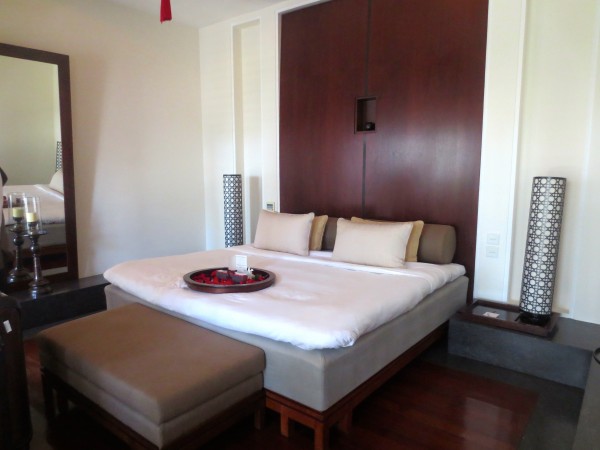

Some of our days were spent lounging around the pools and private beach while we read, worked, and blogged (despite being a luxury hotel, the WiFi was still horrible, a frustrating theme of our whole trip). We would order lunch at the pool and breathe in the peacefulness of the atmosphere and relax.

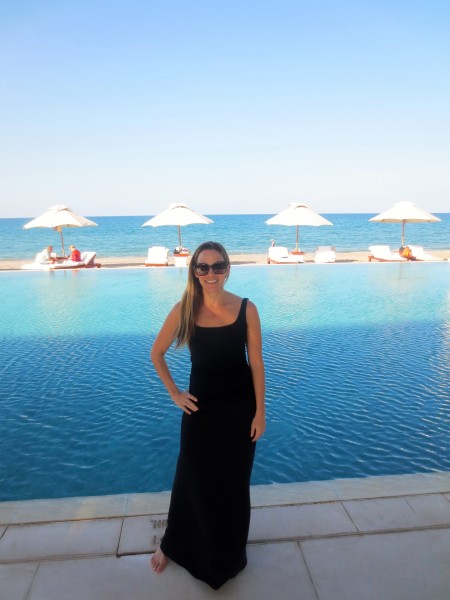






Peter and I also took advantage of the gym, spa, and classes offered at the hotel. I specifically took part in the yoga and boot camp classes. One of my favorite memories was doing yoga outside during sunset. Just as the sun was going down the call to prayer sang as we held our final pose. There was something a bit surreal and magical about that for me.
We also ventured off hotel grounds for a day tour with our guide Faisal. Our first stop was the Sultan Qaboos Grand Mosque which opened in 2001 giving it a more modern feeling with contemporary Islamic architecture. Tourists are allowed to visit the mosques outside of prayer time.


Inside the mosque are a couple world breakers. The 2nd largest handwoven single rug covers the prayer floor of the mosque. It took 400 Iranian women four years to produce this intricate and artistically designed masterpiece. 28 colors were used in this tireless effort by talented women to create something truly spectacular.

The other world breaker is the 2nd largest chandelier in the world. Made up of all Swarovski crystals and is nearly 46 feet tall. The massive size of the mosque causes a bit of an optical illusion making this massive centerpiece appear smaller than its actual size.

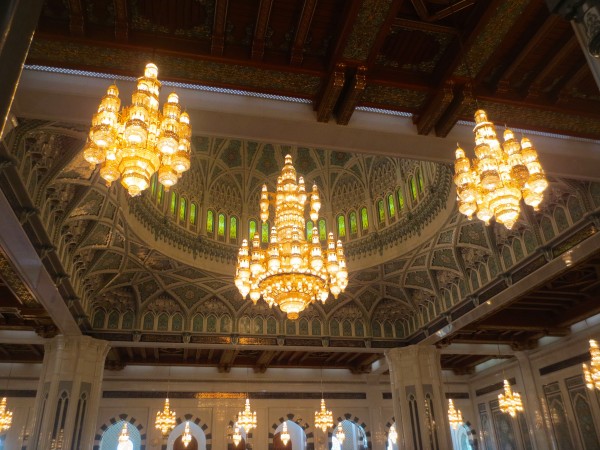
After exploring the inside of the mosque we were taken to a hospitality room where local women served us dates and Arabic coffee and offered dialogue about Islam. We were instructed to ask any questions. I asked her about the differences in her life inside her home and outside. “I’m a different person at home,” she replied. In Arabic culture, under their interpretation of the Koran, women are to cover their bodies and heads outside of their home. However, she further explained to me with an almost mischievous smile: “I dress up. I wear heels. If its just me and my girlfriends, we can wear what we want uncovered, though if a man is around, other than my husband, we will cover.”
In their culture it is important to blend in and uphold a humble and modest attitude. This is achieved by the way men and women dress. Men wear long white robes, thwab and a keffiyah on their heads – very conservative. Typically the keffiyah is red and white. The women wear black which is helpful for protection from the sun because the rays attract light not heat. Therefore they are protected from being burned and are able to remain cool as well.
She told me about the five daily prayers in the Muslim religion. Every morning she rises well before sunrise and gives thanks for her blessings and the new day. She teaches her children the same. To wake up and be thankful for “your eyes to see, your feet to walk.” This prayer and ritual is done five times throughout the day and always with a reminder with the call-to-prayer being played on speakers bouncing off the city streets and walls. It’s really quite beautiful. The majority of Muslims are devout pious people who view their religion as peaceful. In a religion with 1 billion followers more than 99% do not support extremist views. However that doesn’t stop many non-Muslims from having anxious thoughts if they see a man in a turban boarding their flight or labeling a woman as “repressed” if she identifies to her culture by covering.
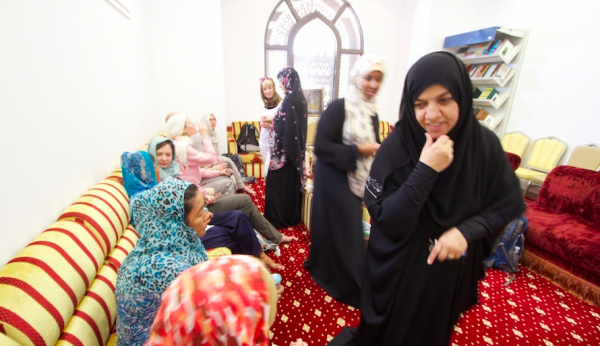
Next we visited the Bait Al-Baranda which was a snooze feast and when we started to realize our guide wasn’t the greatest. He sort of just dropped us off at the museum door without any background. There was no receptionist either. We amused ourselves with random pictures though as we were the only visitors at the bizarre venue.

We walked along one of the famous sea-side promenades in Muscat and our guide pointed out the Sultan of Oman’s yacht. I reached for my phone almost simultaneously Googling, ‘how to make friends with a Sultan.’
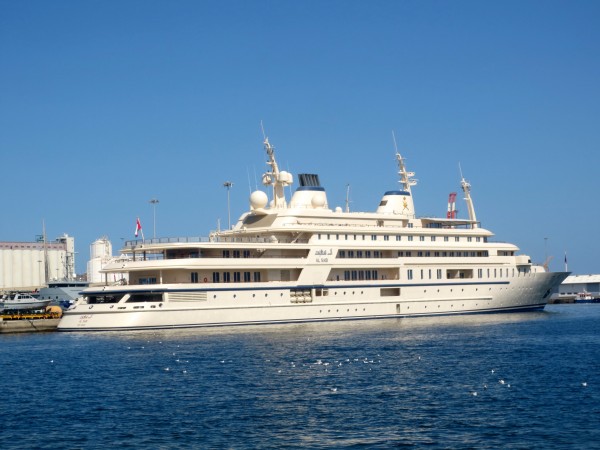
After this stroll we walked over to explore the Mutrah Souk which was a maze of locals shops where bargaining is encouraged. You would think I would have been shopped out at this point, but I wasn’t, much to the dismay of Peter. Walking through the energy of these Souks is fun and you get to see things like a store specializing in abayas for women. The vendors in the Souk told us that we just missed Secretary of State John Kerry who took some time from his diplomatic schedule to visit this very Souk the day before. He probably got an invite to the yacht. I bought some more scarves.

Our last stop was Al Alam Palace, the Sultan’s palace. Although Sultan Qaboos lives elsewhere in Oman entrance is not permitted; you are allowed to walk the grounds and take pictures. The Sultan Qaboos is really, really beloved in Oman as he took a poor country to what is now - a rich and flourishing country under his rule since 1970. He took advantage of the oil wealth and raised the standard of living making Oman a safe and pleasant place to live with a growing tourism industry. Qaboos has also managed to become allies with the US and the UK as well as partner with Iran while also building economic ties with Asian powers such as China, Pakistan, and India. It had been rumored that the Sultan is terminally ill and when he missed the Eid holiday just a couple weeks before that fear rose. At this time there is no one to take his place. Very little is known about his succession plan. He has no children (in fact, its widely rumored that he may be a homosexual which would be insanely ironic given their 3 year sentence for homosexuality), and no one is publicly prepped to take the reigns when the inevitable occurs. The Omanis we spoke with all seem concerned about the future of the country.




Our second to last evening we ventured to the Royal Opera House where we attended the ballet and was treated to a production of Ballett am Rhein Düsseldorf Duisburg led by European award wining director and choreographer Martin Schläpfer. We were lucky because the Opera House only has shows three months out of the year and the show we attended was a a modern contemporary ballet. The music, costumes, and dance moves were all such a treat. Of course the building itself is additionally inspiring made out of white marble and Omani architecture. The patrons were dressed to the nines and we rubbed elbows with Muscat’s elite in the whos-who of international oil tycoons and their dolled up arm-candy.



On the other nights we stayed at the hotel we and took advantage of the free happy hour, hotel restaurants and the shisha lounge. I was always a bit fascinated to sit with Peter while we sat smoking shisha with various groups of men and women who all set separate wearing their traditional clothing. Women in their black abayas with hot pink heels peeking out from the bottom. Men all wearing white robes with a red and white checkered keffiyeh. I felt significantly far from home in those instances, but also happy to be experiencing a world so vastly different.

Our last night in both Oman and the Middle East we treated ourselves to a nice dinner at the Beach Restaurant located at the hotel by the sea. Afterwords we walked the grounds one last time taking in the beauty and zen of where we were.


In the morning we were both beyond excited to start our next big adventure in Africa. First stop Nairobi the capital of Kenya.
Thanks as always friends and family. Sending lots of love to all of you.
